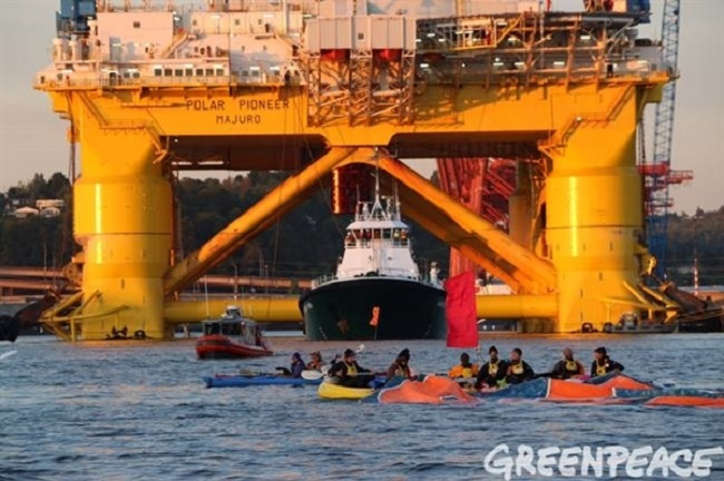Dozens of environmental activists blockaded Royal Dutch Shell's Drilling Rig, Polar Pioneer, delaying its departure from Seattle's Elliott Bay bound for the Arctic on June 15, 2015.
The Polar Pioneer is one of two drilling vessels heading towards the Arctic for Shell this year, searching for oil. The second, the Noble Discoverer, is one of the oldest drillships in the world.

Image: Greenpeace
Authorities reported that the drilling rig left its temporary base in Seattle on Monday for its trip north to Alaska, as dozens of activists in kayaks tried to stop it.
In a live video footage, local media showed how the rig was being towed out of its terminal at the Port of Seattle, while kayakers fanning out in an arc.
The Coast Guard officers detained twenty-five people for violating a safety zone around the vessel. Each one of them was fined to pay $500.
The rig paused at Bainbridge Island, west of Seattle, and there was an information released that it had beached.
According to Coast Guard spokesman George Degener, the reports were incorrect and the rig was changing towing configuration.
Mike O’Brien, a City Council member in Seattle, was among the activists who paddled out to oppose Shell’s plans to resume drilling for fossil fuels in the Arctic, which is one of the world’s most ecologically sensitive regions.
Environmental groups expressed their concerns over the oil search in the remote Arctic that could lead to a disaster in the region. The Arctic is an area that helps regulating the global climate because of its vast layers of sea ice.
Furthermore activists say an eventual oil spill would be nearly impossible to handle in Arctic conditions. From the other side, Shell has told federal officials that the company would be able to remove 90 to 95 percent of any oil spill.
Activists in Alaska have also vowed to keep pressure on the company ahead of its return to the Chukchi and Beaufort Seas, home to whales, walrus and polar bears.
The Coast Guard informed that they will remain with the vessel while passing through the Strait of Juan de Fuca and then will leave it, when it hits the open waters of the Pacific Ocean.